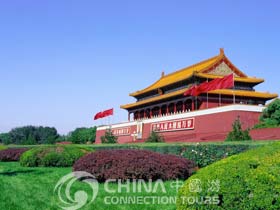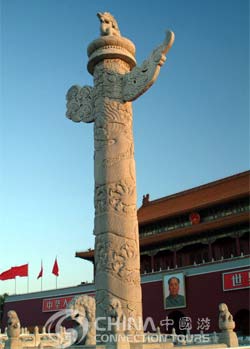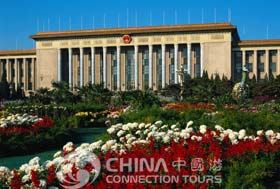
 Tian'anmen Square located in the heart of Beijing, and occupies an area of 440,000 square meters, big enough to hold half a million people. The square has witnessed the Chinese people's struggle against foreign aggression and reactionary rule at home. And also this was the site when in 1949, from a rostrum on the Gate of Heavenly Peace; Chairman Mao announced the establishment of the People's Republic of China. For over a hundred years, many ceremony and demonstrations have been held here. Today the square is a place for people to wander and fly kites.
Tian'anmen Square located in the heart of Beijing, and occupies an area of 440,000 square meters, big enough to hold half a million people. The square has witnessed the Chinese people's struggle against foreign aggression and reactionary rule at home. And also this was the site when in 1949, from a rostrum on the Gate of Heavenly Peace; Chairman Mao announced the establishment of the People's Republic of China. For over a hundred years, many ceremony and demonstrations have been held here. Today the square is a place for people to wander and fly kites.
Many tourists to Tian'anmen Square would like to have their pictures taken in front of the white marble Jinshuiqiao (Gold Water Bridges). The bridges were named after the Gold Water River they span, Seven bridges, each supported by three arches, cross the Outer Gold Water River in front of Tian'anmen, Zhongshan Park, and the Beijing Working People's Palace of Culture. Five one-arched bridges cross the Inner Gold Water River inside the Forbidden City between Wumen (Meridian Gate) and Taihemen (Gate of Supreme Harmony).
The grandeur of Tiananmen Gate (Heavenly Peace Gate) is a national symbol, with the Great Hall of the People on the western side and the Museum of the Chinese Revolution and the Museum of Chinese History to its east and west. The Monument to the People's Heroes - the 36 meters obelisk, made of Qingdao granite, dominates the center of the square. The Chairman Mao Memorial Hall and the Qianmen gate, sit in the south.
Tian'anmen Gate
Tian'anmen Gate (Gate of Heavenly Peace) was built in the 15th Century and restored in the 17th Century. From imperial days, the yellow glaze-tiled double-eaves tower functioned as a rostrum for proclamations to the assembled masses. October 1, 1949, Chairman Mao Zedong proclaimed the founding of the new China. The tower has five doors and in front of it are seven bridges spanning a stream. Only the emperor could use the central door and bridge. On the top of the central door is a gigantic portrait of Chairman Mao with slogans on each side stating 'Long Live the People's Republic of China' and 'Long Live the Unity of the Peoples of the World'. Walking through the gate, you can enter the imperial city - Forbidden City.
Huabiao
 Right beside a pair of marble lions in front of the Tian'anmen Gate stand obelisk of marble engraved with entwisting dragons and clouds - an ornamental architecture called Huabiao. Its history can be traced back to the Yao and Shun, legendary kings in remote antiquity. To solicit public criticism, it is said that wooden crosses were erected at marketplaces for people to write down complaints. Later during the Han (206 B.C. -- 220 A.D.) wooden posts were replaced by stone pillars, which gradually became the sumptuous columns to palace gates. Huabiao can be usually found in imperial gardens and mausoleums. On the top is a plate-shape flat called Chenglupan (dew-collecting) on which squats an animal called kong (a legendary animal for watch-keeping) facing to the south. They were called "Wangjungui" or "looking forward to the emperor's return," who watched over the emperor's excursions and called him back. The couple inside the gate facing north, called Wangjunchu or "looking forward to the emperor's progress," were considered to supervise the emperor's behavior in the court when he neglect court affairs.
Right beside a pair of marble lions in front of the Tian'anmen Gate stand obelisk of marble engraved with entwisting dragons and clouds - an ornamental architecture called Huabiao. Its history can be traced back to the Yao and Shun, legendary kings in remote antiquity. To solicit public criticism, it is said that wooden crosses were erected at marketplaces for people to write down complaints. Later during the Han (206 B.C. -- 220 A.D.) wooden posts were replaced by stone pillars, which gradually became the sumptuous columns to palace gates. Huabiao can be usually found in imperial gardens and mausoleums. On the top is a plate-shape flat called Chenglupan (dew-collecting) on which squats an animal called kong (a legendary animal for watch-keeping) facing to the south. They were called "Wangjungui" or "looking forward to the emperor's return," who watched over the emperor's excursions and called him back. The couple inside the gate facing north, called Wangjunchu or "looking forward to the emperor's progress," were considered to supervise the emperor's behavior in the court when he neglect court affairs.
Great Hall of the People
 This is the venue of the legislature, the National People's Congress. Summit meetings are often held in the 10,000-seat auditorium with the familiar red star embedded in a galaxy of lights in the ceiling. Also you can visit the 5000 seat banquet room where US president Richard Nixon dined in 1972. Monument to the People's Heroes (Renmin Yingxiong Jinianbei), built in 1958 on the southern side of Tian'anmen Square, this 36-meter obelisk bears brass-relief carvings of key revolutionary events such as the Chinese destroying opium in the 19th century.
This is the venue of the legislature, the National People's Congress. Summit meetings are often held in the 10,000-seat auditorium with the familiar red star embedded in a galaxy of lights in the ceiling. Also you can visit the 5000 seat banquet room where US president Richard Nixon dined in 1972. Monument to the People's Heroes (Renmin Yingxiong Jinianbei), built in 1958 on the southern side of Tian'anmen Square, this 36-meter obelisk bears brass-relief carvings of key revolutionary events such as the Chinese destroying opium in the 19th century.
Mao Zedong Memorial Hall (Mao Zhuxi Jiniantang)
Behind the Monument to the People's Heroes is the hall where the embalmed body of Chairman Mao is kept and many Chinese show deep respect when confronted with the physical presence of Mao.

